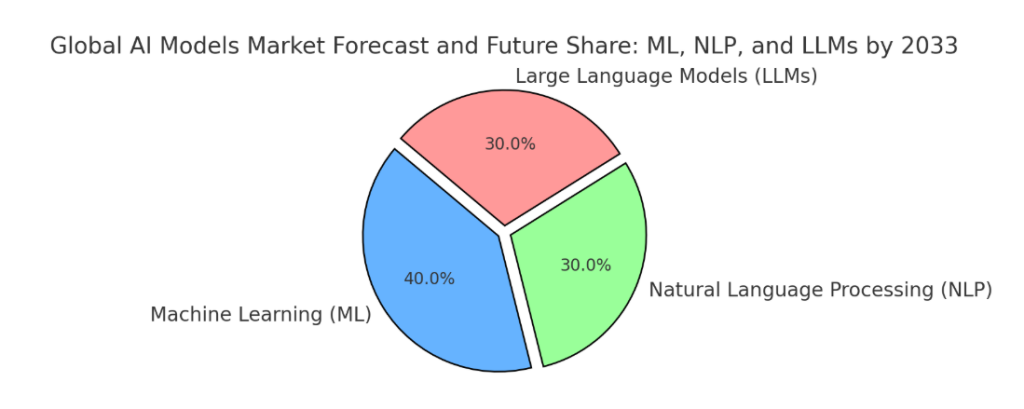Artificial intelligence is no longer just a futuristic concept—it has become a cornerstone for industries worldwide. From healthcare and finance to retail and e-commerce, AI models are driving efficiency, automating processes, and enabling smarter decision-making. According to projections, the AI models market forecast is expected to reach $4,120 billion by 2033, reflecting both rapid adoption and significant technological advancement.
We have personally observed companies embracing AI to streamline operations, enhance customer experiences, and gain predictive insights. This growth is not accidental; it is fueled by the convergence of data availability, computing power, and diverse AI applications that solve real-world problems.
Strategic Outlook: Expected Milestones in the AI Models Market by 2033
The AI models market is projected to soar from about $23 billion in 2024 to nearly $4,120 billion by 2033, reflecting an impressive 28% compound annual growth rate (CAGR). This rapid expansion highlights how machine learning (ML), natural language processing (NLP), and large language models (LLMs) are becoming core technologies across global industries. In parallel, the embodied AI market is expected to reach approximately USD 10.75 billion by 2034, signaling growing demand for AI systems that can interact with the physical world as seamlessly as they process data.
Projected Percentage Shifts Defining the AI Models Market Path:
- By 2026, more than 62% of Fortune 500 companies are expected to run at least one AI model within critical operations, compared to 45% in 2024, showing a 17-percentage-point jump in just two years.
- By 2028, AI training infrastructure is set to consume nearly 25% of enterprise IT budgets, topping $250 billion, with BlackRock and Microsoft investing $30 billion to fuel growth.
- By 2030, the Asia-Pacific region’s share of the global AI market is forecast to climb from 18% today to 30%, while North America’s dominance may narrow from 55% to about 45%, signaling a 10-percentage-point shift in regional balance.
- By 2033, enterprise-scale LLM implementations are expected to generate roughly 35% of total AI model revenues, with deployment costs rising as much as 50% year over year for high-capacity systems.
- Across all sectors, AI-driven automation is predicted to account for 40% of productivity gains, compared with roughly 15% in 2024, demonstrating a 25-percentage-point increase in measurable business impact.
These percentage-driven forecasts underscore how rapidly the landscape is changing. Companies that plan early, allocate resources strategically, and continuously refine their data pipelines will be best positioned to benefit from the multi-trillion-dollar opportunities the AI models market forecast reveals for the coming decade.
Important Factors Fueling the Surge in the AI Models Market
The surge in the AI models market forecast is backed by multiple factors that are shaping adoption across industries:
- Expanding Data Volumes: Organizations generate massive amounts of data daily, creating opportunities for AI to analyze patterns and predict outcomes.
- Advanced Computing Infrastructure: Cloud services, GPUs, and AI-specialized chips make complex model training more efficient.
- Cross-Sector Applications: Industries such as healthcare, finance, automotive, and retail are rapidly integrating AI solutions.
- Strategic Investments: Governments and enterprises are funding AI research and infrastructure at unprecedented levels.
Admittedly, companies with robust data resources and technical expertise are taking the lead, demonstrating the competitive advantage AI models can provide.
How Different AI Models Are Powering Market Expansion
The AI models market forecast includes multiple types of models, each suited to specific tasks and business needs.

Machine Learning for Predictive Insights (ML Model)
Machine learning (ML) remains one of the most widely deployed AI solutions. It helps organizations:
- Predict customer churn and retention trends
- Detect fraud in real time
- Optimize supply chain operations
We’ve implemented ML models in several projects and found them highly adaptable, capable of learning from data and delivering actionable results.
Natural Language Processing for Conversational AI (NLP Model)
NLP models are transforming how businesses handle communication, powering chatbots, sentiment analysis tools, and document classification systems. Core applications include:
- Automated 24/7 customer support
- Real-time translation and multilingual assistance
- Organizing and summarizing large datasets
In particular, NLP models are indispensable for industries that rely on continuous customer engagement and information processing.
Large Language Models for Advanced Interaction (LLM Model)
Large language models (LLMs) have taken AI to the next level, enabling:
- Human-like content generation
- Multi-turn conversational AI for virtual assistants and digital companions
- Research summarization and knowledge base creation
We’ve observed LLMs being adopted in applications such as AI girlfriend, where retaining context and providing nuanced responses is critical. Despite their sophistication, LLMs require significant computing power and operational budgets, making them suitable primarily for large-scale enterprise implementations.
Crunching the Numbers: Insights from the AI Models Market Forecast
The projected growth highlights both opportunity and scale. Important numeric insights include:
- Current Market Size: $1,120 billion in 2024
- Forecast by 2033: $4,120 billion
- CAGR: 15.2% over the next decade
- Adoption: 45% of Fortune 500 companies currently use AI; projected 62% by 2026
- Investments: AI startups raised $12 billion in 2024, up 35% from 2023
- Regional Distribution: North America 55%, Europe 20%, Asia-Pacific 18%, with Asia growing at 32% CAGR
Clearly, the market growth is being fueled by both technological advancement and increasing adoption across sectors.
Industry-Specific Adoption Trends
Adoption patterns vary widely depending on the industry:
Healthcare
- Predictive analytics to forecast patient outcomes
- NLP models for organizing medical records
- LLMs to assist in research and generate reports
Finance
- Fraud detection and credit scoring
- Customer service automation via chatbots
- Market trend prediction through ML models
Retail and E-Commerce
- Personalized shopping recommendations
- Demand forecasting and inventory optimization
- AI Integration with AI-powered recommendation engines
Manufacturing and Logistics
- Predictive maintenance for machinery
- Resource allocation optimization
- Supply chain risk assessment and management
We’ve noticed that industries like top onlyfans models combining large datasets with high-stakes decisions tend to realize the most immediate benefits from AI integration.
Cost Breakdown and Financial Planning for AI Model Implementation
Implementing AI models comes with varying costs depending on scale and model type:
- Data Preparation (20–40% of total budget)
- Small projects: $1,000–$5,000
- Mid-scale projects: $10,000–$50,000
- Enterprise-level: $100,000+
- Small projects: $1,000–$5,000
- Training and Infrastructure
- Basic ML: $5,000–$15,000
- NLP or computer vision models: $20,000–$100,000
- LLMs: $200,000–$1M+ annually
- Basic ML: $5,000–$15,000
- Integration and Deployment
- Small-scale: $2,000–$10,000
- Advanced enterprise systems: $25,000–$150,000
- Small-scale: $2,000–$10,000
- Maintenance and Updates
- Basic monitoring: $500–$2,000/month
- Enterprise-level support: $10,000–$50,000/month
- Basic monitoring: $500–$2,000/month
Not only do these numbers illustrate financial requirements, but they also emphasize strategic planning for a successful ROI.
Effective Strategies for Seamless AI Model Integration
Successfully deploying AI models requires careful planning and execution:
- Define Objectives: Match model type to specific business challenges
- Prepare Data Thoroughly: Clean, label, and validate datasets
- Train, Validate, and Test: Split data to optimize performance and accuracy
- Deploy Strategically: Implement via APIs or integrated applications
- Monitor Continuously: Retrain and update models to prevent performance drift
- Utilize Established Platforms: Tools like TensorFlow, PyTorch, and Hugging Face streamline deployment
Consequently, organizations that follow structured integration methods and utilize a comprehensive AI tools directory can more effectively select, deploy, and monitor AI models, leading to measurable results and long-term sustainable benefits.
How Geographic Markets Influence AI Models Growth
The AI models market forecast also reflects distinct regional trends:
- North America: Technology hub with the highest adoption and investment
- Europe: Focused on finance, industrial automation, and regulatory-compliant solutions
- Asia-Pacific: Fastest-growing region with 32% projected CAGR, driven by manufacturing, retail, and e-commerce
In comparison to other regions, we observed that Asia-Pacific’s rapid growth is fueled by increasing digital transformation initiatives and infrastructure investments.
What the Future Holds for the AI Models Market
The AI models market forecast indicates continued acceleration driven by several key trends:
- Integration with IoT and edge computing solutions
- Expansion of LLMs for enterprise and consumer applications
- Increasing adoption of AI-powered virtual assistants and digital companions
- Automation of knowledge-intensive tasks across sectors
Eventually, AI models will not only augment decision-making but also reshape business operations, creating new efficiencies and revenue opportunities.
Final Thoughts on the AI Models Market
ML, NLP, and LLM models are transforming industries worldwide, and the AI models market forecast is expected to reach $4,120 billion by 2033. Deployment costs range from $10,000 for smaller projects to over $1.5 million annually for enterprise-scale LLM systems. Key sectors like healthcare, finance, retail, and manufacturing are seeing significant benefits.
Organizations that plan strategically, integrate AI thoughtfully, and maintain ongoing monitoring achieve measurable results, making AI adoption a critical factor for long-term growth and competitiveness.



